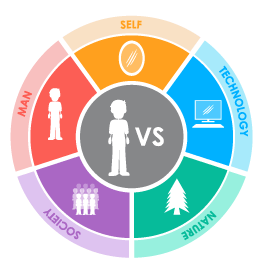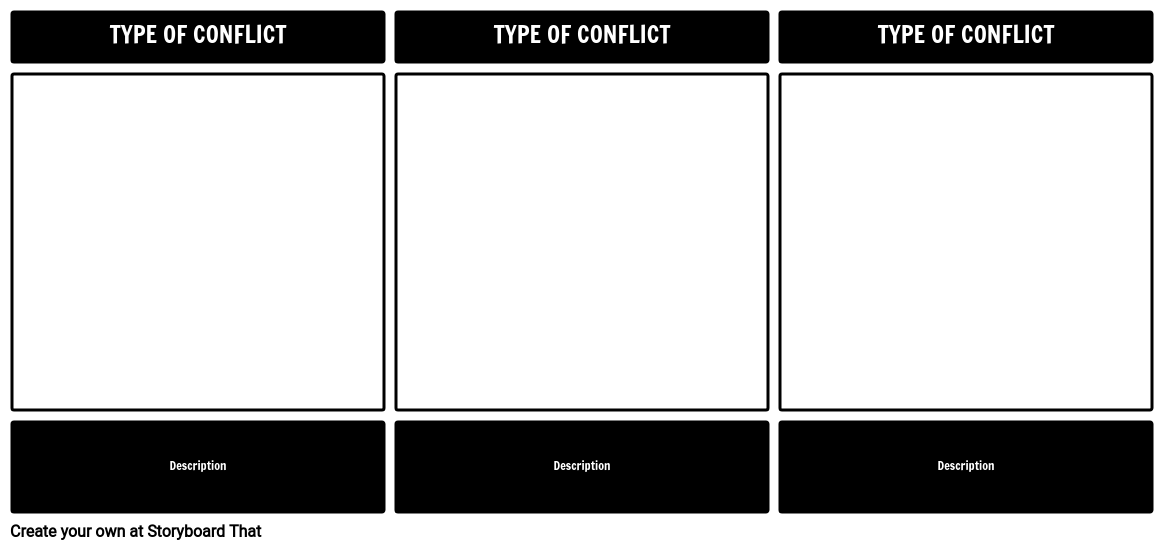Activity Overview
Storyboarding is an excellent way to focus on types of literary conflict. Have your students choose an example of each literary conflict and depict them using the Storyboard Creator. In the storyboard, an example of each conflict should be visually represented, along with an explanation of the scene, and how it fits the particular category of conflict.
Examples of Literary Conflict in The Catcher in the Rye
MAN vs. MAN
Holden and Stradlater get into a physical fight because Holden is upset that Stradlater took Jane Gallagher out on a date. He thinks Jane is too good for Stradlater, and he’s annoyed that Stradlater won’t tell him what they did on their date. He is also annoyed that Stradlater didn’t like his composition about Allie’s baseball mitt.
MAN vs. SELF
Holden remembers a time when he should have invited Allie to come out and shoot BB guns with him and Bobby Fallon, but instead, he told him he was too young. Holden now tells Allie sometimes to go get his bike and meet them, revealing he has some unresolved guilt and grief about Allie’s death. Later, as his mental breakdown worsens, he asks Allie not to let him disappear.
MAN vs. SOCIETY
Holden is constantly concerned with things that the rest of society either doesn’t want to think about, or doesn’t care about. For instance, Holden is concerned with where the ducks from Central Park go in the winter; he is legitimately afraid that they don’t have anywhere to go, much like him. He is also upset by the profanity he finds carved into the walls at Phoebe’s school, because he sees signs like that as threatening the innocence of children who read them.
Template and Class Instructions
(These instructions are completely customizable. After clicking "Copy Activity", update the instructions on the Edit Tab of the assignment.)
Student Instructions
Create a storyboard that shows at least three forms of literary conflict in The Catcher in the Rye.
- Identify conflicts in The Catcher in the Rye.
- Categorize each conflict as Character vs. Character, Character vs. Self, Character vs. Society, Character vs. Nature, or Character vs. Technology.
- Illustrate conflicts in the cells, using characters from the story.
- Write a short description of the conflict below the cell.
Lesson Plan Reference
- [ELA-Literacy/RL/9-10/3] Analyze how complex characters (e.g., those with multiple or conflicting motivations) develop over the course of a text, interact with other characters, and advance the plot or develop the theme
- [ELA-Literacy/RL/9-10/5] Analyze how an author’s choices concerning how to structure a text, order events within it (e.g., parallel plots), and manipulate time (e.g., pacing, flashbacks) create such effects as mystery, tension, or surprise
- [ELA-Literacy/RL/9-10/6] Analyze a particular point of view or cultural experience reflected in a work of literature from outside the United States, drawing on a wide reading of world literature
Rubric
(You can also create your own on Quick Rubric.)
| Proficient | Emerging | Beginning | Try Again | |
|---|---|---|---|---|
| Conflict Identification | Student identifies correct major conflicts and uses strong, clear textual evidence to support choice. | Student identifies correct major conflict and uses few or unclear details to support their choice. | Student identifies incorrect major conflict, and uses some details from the text to support their choice. | Student does not attempt to identify major conflict or identifies incorrect major conflict with no explanation. |
| Understanding Outcome | Student clearly shows the outcome of the conflict and its effects on the protagonist with evidence from the text. | Student shows the outcome of the conflict and its effect on the protagonist, but some evidence is unclear. | Student shows the outcome of the conflict, but does not examine its effect on the protagonist and uses some vague textual evidence. | Student does not clearly show the outcome of the conflict or use textual evidence. |
| Character | Storyboard includes all required characters and clearly names them. Goes above and beyond by adding additional details. | Storyboard includes all required characters and clearly names them. | Storyboard includes protagonist and antagonist but leaves out other required characters. | Storyboard does not include the names of required characters. |
| Storyboard | Student clearly shows effort to convey the setting the scene of the book | Student attempts to convey setting and scene of the book, but lacks some clarity. | Student does not clearly convey the setting and scene. | Student makes little or no attempt to convey the setting or scene. |
| Spelling and Grammar | Student uses exemplary spelling and grammar. There are no errors. | Student makes a minor error in spelling and grammar. | Student makes several minor errors in spelling and grammar. | Student makes many errors in spelling and grammar; little attempt at spellchecking. |
More Storyboard That Activities
Catcher in the Rye, The
© 2024 - Clever Prototypes, LLC - All rights reserved.
StoryboardThat is a trademark of Clever Prototypes, LLC, and Registered in U.S. Patent and Trademark Office









